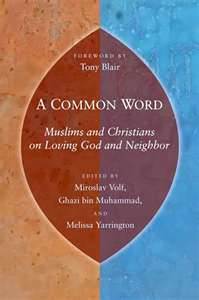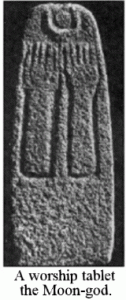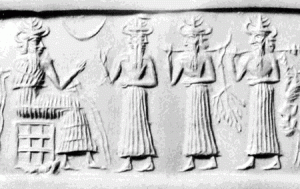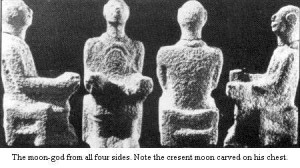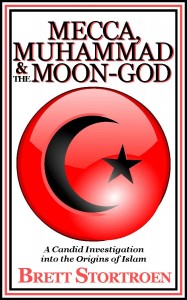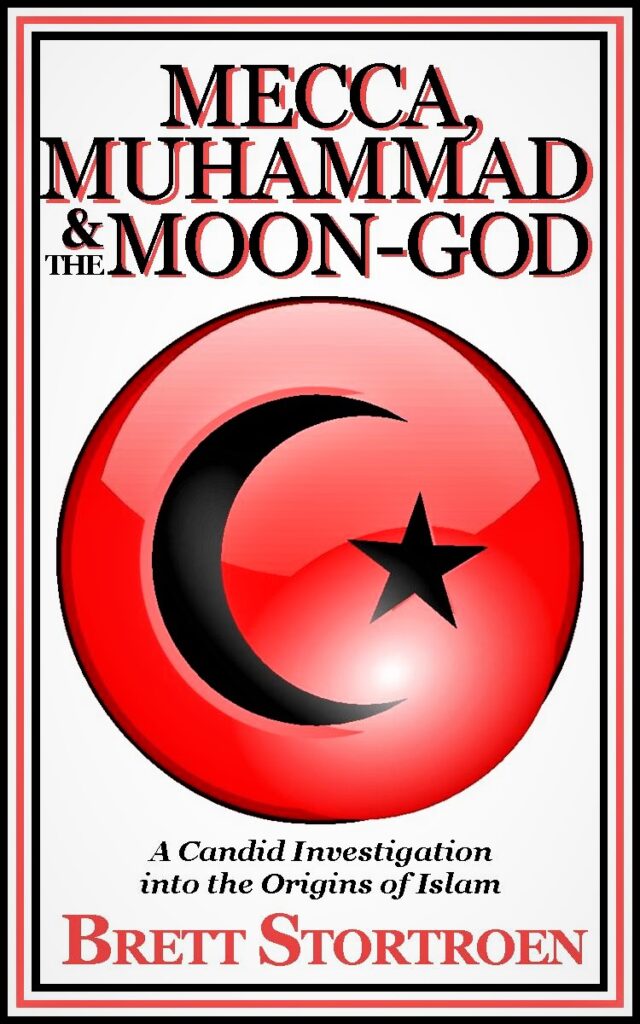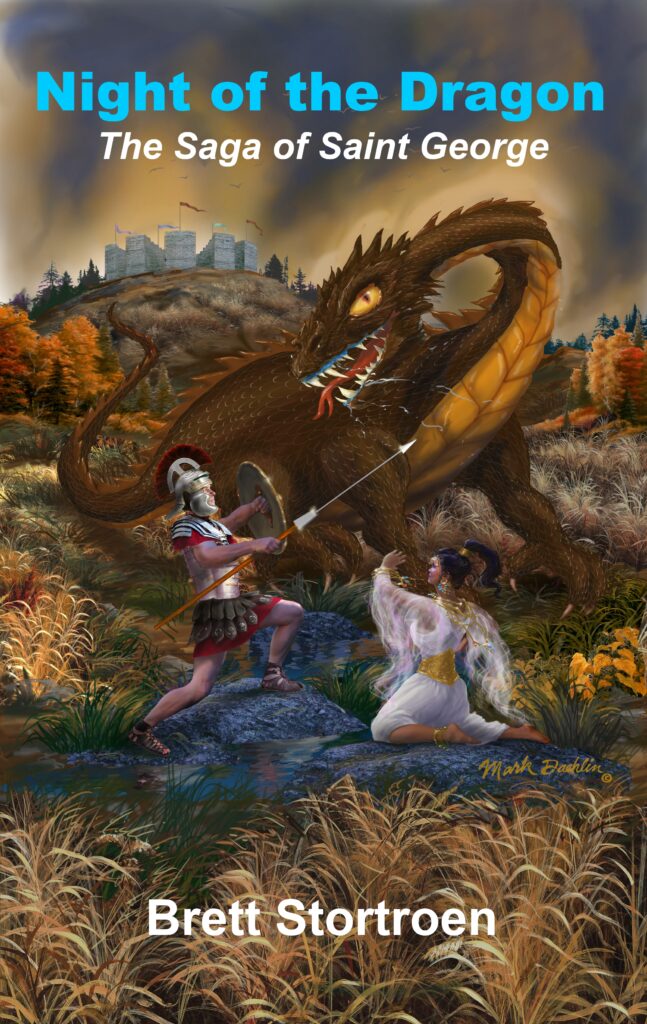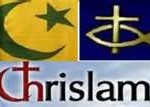
Many Christians and Jews believe that Allah or his other pseudonym, ar-Rahman (Merciful One), and Yahveh are one and the same. Considering the vast archaelogical and historical source material to the contrary, one cannot logically make this sort of equivocation. Allah arose out of the pagan milieu of astrological rites and centered on the moon-god worship among the groves. Nowhere does historical empirical evidence mention the name Allah in reference to the Judaic God of the Jews or Christians.
There has been a disturbing recent trend among the Christian and Jewish churches to make appeasement to the Islamic community. This new movement has been dubbed “Chrislam.” and is an attempt to blend Christianity with Islam. It is a syncretistic movement rooted in Nigeria and has spread worldwide. In July of 2008 in a conference at Yale University, the most stunning example of this surrender and acquiescence to Islam was initiated; 300 prominent Christian leaders signed a letter called, “A Common Word Between Us and You.”
This letter was written in the name of the “All Merciful” which implies the same god as Allah. How can these ministers of the gospel become so deceived when it comes to matters of such importance? Furthermore, the Qur’an denies the divinity of Christ over and over again. Again, how can these leaders ignore these facts and commit blatant apostasy? They even glossed over the fact that the letter used a capital “P’ whenever Muhammad was cited as the Prophet of God which implies his superiority over all other prophets. This usage was not in quoted Islamic source material but actually in the main body of the letter. There can be no excuse on the part of these church leaders when it comes to outright apostasy. If they were misled or deceived due to some of the language employed, they should recognize this fact, and admit their error. Numerous web sites display the signatories of this letter. It is not the author’s wish to instigate feuds within the church but when it comes to matters of such grave importance of eternal salvation, the issue must be addressed. There is ample precedence for such confrontation in the church, for instance, did not the Apostle Paul rebuke Peter at one time concerning the matter of what was clean and unclean? The matter was sorted out quickly, so that there would be no more confusion in the early church. Likewise, this important matter must be addressed within the church before it leads many astray.
Archaelogical Evidence Refuting Chrislam:
ALLAH AS THE MOON-GOD OF ARABIA
Throughout the ancient Near East, the moon-god was worshipped by numerous names: (1) The Sumerian (Nanna), who was the son of the chief god, Enlil; (2) the Akkadian (Sin); (3) Anshar, the primitive father of the gods of the mystic Babylonian creation epic; (4) Anu, god of the heaven (the sky) and chief of all the gods; and (5) the Ugaritic (Kusuh). In addition to proper names, various epithets were given such as (1) Namrasit, meaning “bright rising,” (2) “lord of Ur,” and (3) “lord of Ergishirgal” which was a name of the temple for the moon-god in Ur.[10]
Correspondingly, the moon-god was highly venerated in Arabia and its surrounding regions. Just east of Mecca were the Desert of Sin, the Desert of Sinai, and Mount Sinai named possibly after the moon-god, Sin, by the traveling Bedouin.[11] Perhaps the biblical account described Mt. Sinai by the name, Horeb, so as not to confuse Yahveh with the moon-god, Sin. The Old Testament was firm in its rebuke of the moon-god cult (Deut. 4:19; 17:3; 2 Kin. 21:3,5; 23:5; Jer. 8:2; 19:13; Zeph. 1:5).[12]
Robert Morey, in The Moon-god Allah: In the Archaeology of the Middle East, described a temple to the moon-god that was excavated at Hazor,Palestine in the 1950’s:
Two idols of the moon-god were found. Each was a statue of a man sitting upon a throne with a crescent moon carved on his chest. The accompanying inscriptions make it clear that these were idols of the moon-god. Several smaller statues were also found which were identified as the “daughters” of the moon-god.[13]
In the preceding chapter, the goddess al-Lat had been postulated as the sun goddess, but it appeared more likely that she, along with her sisters, al-Uzza and Manat were daughters of the moon-god and sun-goddess. Or, perhaps al-Lat (Atirat/Ashirat) was indeed the sun goddess. Sometimes these gods have dual roles depending on their location.
In addition to the finds in Hazor, there exist thousands of reliefs and votive bowls used in the cults to the three daughters of Allah. It is significant to note Morey’s exposition that “The three daughters, al-lat, al-Uzza, and Manat are sometimes depicted together with Allah the moon-god represented by a crescent moon above them.”[14]
Nabonidus, the last king of Babylon, established a major cult site to the moon-god in Tayma, northern Arabia. Evidently, south Arabia was also dominated by moon worship. Eliade states:
Each people worshipped its own god: Wadd (the Mineans), Amm (the Qatabanians), Sin (the Hadhramautis), and Ilumquh (the Sabeans). . . . Among South Arabian temples, two are well known: The temple of Huraydah (Hureidha) in Hadhramaut, dedicated to Sin, the local moon-god, and the temple of Awwam (Haram Bilqis) in Ma’rib dedicated to Ilumquh, the Sabean moon-god.[15]
While the name “Ilumquh” may be transliterated as “il muqahh(w),” the god who waters, his consort was the sun goddess Sham.[16] Though Jacques Ryckman in “Le Pantheon de L’Arabie du Sud PreIslamique” claims that Il could be considered as a sun god, he agreed that most scholars have previously regarded Ilumquh as a masculine moon-god.[17]
Considering the milieu of moon-gods in south Arabia, Ilumquh was also regarded as a moon deity. The linguistic history in Arabia designated “il” or “ilah” as a phase of the moon.[18] Il was worshipped also by the name Shahr. David F. Graff, in “Arabia During Achaemenid Times,” remarked: “The name Shahr itself seems to be derived from a designation for the moon-god Sin, on the postulate that Il + Tehri = il + Sahr”[19] Ryckman also associates Sharan with the moon-god.[20]
This particular god was worshipped in north Arabia and called “He of Shara.”[21] The moon-god Sin and the related Il were worshipped in north Arabia, south Arabia, and the far west, consequently, placing Mecca at the exact center of this geographical triangle. Taking this into account, Allah equaled al-Ilah in Arabic; it became easy to demonstrate the correlation to the moon-god of Arabia. Morey gives an excellent summary for this association:
Is it any wonder that the symbol of Islam is the crescent moon? That a crescent moon sits on top of their mosques and minarets? That a crescent moon is found on the flags of Islamic nations? That the Muslims fast during the month of the crescent moon in the sky?[22]
Some Muslims alleged the Muslim Turks did not incorporate the crescent moon symbols on their mosques until the Middle Ages.[23] If this were the case, why did they begin to do this? Was it just coincidence? To those who believe in the supernatural realm, the answer would be obvious. The New Testament explains it this way:
Put on the whole armour of God, that ye may be able to stand against the wiles of the devil. For we wrestle not against flesh and blood, but against principalities, against powers, against rulers of darkness of this world, against spiritual wickedness in high places. Wherefore take unto you the whole armour of God that ye may be able to withstand the evil day, and having done all, to stand (Eph. 6:11-13).
People or nations may be influenced via the evil spirits in the heavenly realms. The powerful moon-god exists as a deceptive and cunning demon god of mighty stature and rank who dominates those within his stronghold. The pre-Islamic roots originating from ancient moon occultism and Babylonian astrology draw many victims into it vortex of hate and deceit. The Islamic fruits of demonic inspired barbarism and warfare have been repeatedly demonstrated for fourteen hundred years.
The exclusive nature of Islam concerning salvation may be illustrated from the following sura,
Lo! Those who disbelieve, among the people of Scripture and the idolaters, will abide in fire of hell. They are the worst of created beings” (Qur’an 98:6).
Likewise:
O ye who believe! Take not the Jews and Christians for friends….Lo! Allah guideth not wrongdoing folk” (Qur’an 5:51).
Again, in sura 5:69, the mandatory command to believe in Allah as one’s exclusive Lord, continues to be the mantra of Islam as the stipulation for salvation:
Lo! Those who believe, and those who are Jews, and Sabeans, and Christians—whosoever believeth in Allah and the Last Day and doeth right—There shall no fear come upon them neither shall they grieve.
The requirement to believe in Allah for salvation remains repugnant to those who truly understand the Old Testament and New Testament. Allah is a pagan moon-god with origins in the astrological worship of ancient Arabia. Allah was venerated among the trees, which served as a sacred shrine called a grove. Interestingly, they often used the hard wood tree, oak, which in Hebrew is translated to Allah. Such cult worship is forbidden in the Bible. Originally, the pagan rites included bowing five times a day in separated times, and at different prostrated degrees, to commemorate the astral bodies movements across the sky. Vestigial roots of this practice have been retained in the prayer rituals of Muhammad. In contrast, the worship of the astral bodies among the groves was forbidden by Yahveh and expressly due to the idolatrous demonic influences.
As languages develop, there are at times, intermixing of words and grammar. Ancient Hebrew was the language of Abraham who came from Babylon. Ishmael and Esau’s descendants married with the inhabitants of Arabia and the pre-dialects may have taken on variables as in other languages. Another concept of al-lah’s meaning could be in error due to later changes in the roots of “the god” and later altered to al for the definite article “the” to commemorate everything to al-lah (Allah). The first two letters like in the Chaldean Hebrew El or el, like in the word Elohim Yisrael, may be cited as exemplars. However, in this case, “al” indirectly relates to Allah and became the definite article for “the” in the Arabic language. Also, it could be possible that the word hallah in Arabic means crescent moon and was derived from the mixture of the Bedouin people in early Arabic with the Ancient Hebrew grammatical structure. As an example in Hebrew, an “h” in front of the word would be used to denote the definite article “the” and later this was replaced with “al” in the Arabic language as the definite article “the.” Now, per say, if a mixture did occur in the early formation of the Arabic language, the word H’allah (hallah) meant “the crescent moon” in the predevelopment state of the Arabic language. Without the definite article “a,” allah would mean “a crescent moon.” This would explain the name Allah and the numerous moon-god temples in Egypt and Arabia which influenced the rendering of the name Allah.
Hence, Allah implies the crescent moon that remains the symbol on the flag of many Islamic nations. The name may have its root meaning from the groves that were used as shrines for astrological worship. Thus, allah in Hebrew for hard wood or oak tree is the type of tree which constituted a grove, and there was eventually a transference of the similar word that identified with their moon-god Allah worship among the groves. In any case, H’allah in Hebrew and H’allah in Arabic may be closely linked. Yahveh condemned the grove worship of astrological deification that was identified in the Tanach as H’allah or allah. Archaelology may play a crucial role in determining these variables and their interrelation.
It remains very clear that Arabic has developed like all languages and does not root back to Adam’s original language as so many Muslims expound. Muslims who adhere to Arabic as mankind’s original language deny scientific empirical data. In addition, they deny the biblical account of ancientBabylonand the dispersal of peoples on account of immediate language changes.
Both Islam and Christianity are exclusive religions. If one is accepted, the other must be immediately rejected. Islamic tenets cannot be mixed with true biblical Christianity. The Muslims worship a pagan moon-god and not the Lord of Judaic religious roots. Many Muslims attend Christian churches; however, many still deny the deity of Jesus (Yahsu) and the role of the incarnation event. Some so-called converted Muslims simply accept Jesus as another prophet and denounce him as the Lord of creation. One fabricated rumor that is being taught orally maintains that Yahsu deceived the people by pretending to be God. When he ascended, some Muslims state that the first thing Yahsu must do is apologize to Allah for being a liar and misleading the people. Oral teachings reflect the abhorrence that the Muslims have concerning the deity of Jesus as the Messiah. They hate the idea that a true Christian believes that Yahsu is God Yahveh! From the Judaic frame of mind, apostle John has stated that any man or spirit that denied Yahsu came in the flesh is an anti-Christ. Yahsu denotes Yahveh-Saves. From the view of a Messianic Christian Jew, no man of the Spirit of God can say that Yahsu is not Yahveh. On the Day of Pentecost, 3000 devout Jews called upon Yahsu’s name to save them and they were all monotheists. They did not adhere to any other gods or demi-gods for these were considered false gods. They understood that Yahsu implied Yahveh-Saves. Anyone that denies that Yahsu was really Yahveh in the flesh is not of God! This makes Muhammad a type of anti-Christ prophet.
LIST OF MOON-GOD TEMPLE SITES ON ARABIAN CARAVAN ROUTES
Desert of Sin– Area known to be dedicated to the moon-god Sin.
Ur- One of the earliest temples dedicated to the moon-god.
Haran- An excavated temple to the moon-god.
Tayma – The last king of Babylon, Nabonidus (555-535 BC), established this city to the worship of the moon-god.
Mecca- The Kabah was located here as a temple for 360 astral deities. Allah was the moon-god and considered the high god of this temple.
Marib -Temple to Ilumquh, the Sabean moon-god.
Hureidha -Temple to the moon-god, Sin, excavated in 1944 by G. Caton Thompson.
Egypt- Many sites dedicated to Ishtar, the mythical daughter of the moon-god, Sin.
EVIDENCE TO SUPPORT THE FACT THAT ALLAH WAS A MOON-GOD
–The use of the lunar calendar as the standard in Islam.
–The moon crescent placed above most mosques.
–The major religious festival of Ramadan begins and ends on the moon cycle, just as it was done in pre-Islamic times.
–Archaeological discoveries of moon temples and artifacts found all over Arabian caravan routes.
–The major temple of Islam (the Kabah) was dedicated to astral deities, especially the high god Allah (a moon-god).
–The daughters of the moon-god Allah (Allat, al-Uzza, and Manat) were originally venerated by Muhammad.
–Numerous linguistic connections between the various moon deities in Arabia.
AR-RAHMAN
The beginnings of all the suras in the Qur’an excluding one had the added epigraph: “In the name of Allah, Most Gracious, Most Merciful.”[24] These epigraphs were added after the Qur’an had been compiled into one book. The Arabic equivalents, the “Merciful One” (ar-Rahman) and the “Compassionate One” (al-Rahim), were together references to a deity who had been worshipped in Arabia long before Muhammad’s birth. The god ar-Rahman was assimilated into the Islamic moon-god Allah cult and evidenced throughout the Qur’an.
Muslims argue that the moon-god cult of Il did not exist north of the Hadhramaut (Yemen). Hypothetically, the occult practice did not penetrate into the region of Mecca.[25] However, this has already been proven false in the preceding section. Certainly, the cult of Il had been worshipped from south Arabia to north Arabia. Likewise, the cult of ar-Rahman (al-Rahim) has been established through Jewish influence in southern Arabia as well as in central Arabia, al-Yamama.
Inscriptions from the fourth and fifth centuries C.E. had been found in south Arabia giving evidence to the cult of “Rahmanism.” It was equated to the term “Hanifism” in the Qur’an.[26] A Jewish king named Dhu Nuwas reigned in the Yemen during the “first half of the sixth century.” He had been well known throughout the Near East in many languages such as; Greek, Syriac, and various Arabic dialects. His fame was due to hyper-persecution of the Abyssinian Christians in south Arabia. He had been often “referred to as Masruq and the crucifier throughout the Christian Book of the Himyarites.” He would trick the Christians into surrendering by false promises; if they would swear “by the Merciful One” (Rahmana) they would not be harmed. Yet, as soon as they gave themselves up, he executed them.[27]
Peters relates his findings concerning the evolution and final synthesis of the name of god in the Qur’an:
…in the early Meccan suras Muhammad almost invariably refers to the deity not as Allah but rather, as we have seen, as Lord or, because God is often the speaker, your Lord. It is patently not the name of some new divinity, some god whose presence at Mecca was previously unknown; rather, it is an appellative, a reference to a familiar. Who is Muhammad’s “Lord”? …Sometime after the beginning of his preaching, perhaps after two years, Muhammad begins to use the name al-Rahman, “The Merciful One,” for his God, and conspicuously, in suras 56, 68, 78, 89, and 93 lord and Rahman are used side by side, with no mention of Allah. Unlike ‘Lord,’ Rahman is a name, always used with the article and quite different from the various other appellatives applied to God in the Qur’an. And it is a name with a history, a history unconnected with Mecca, where the pre-Islamic cult of “al-Rahman” remains unattested. Where Rahman was worshipped was in the Yemen and even more interesting, because there is a direct connection with Muhammad, in the area of central Arabia known as al-Yamama.[28]
Peters emphasized how the title al-Rahman was used over fifty times in the suras “of the so-called second Meccan period, and often explicit reference to the fact that the Meccans found the name strange” or unacceptable. He cited Suras 21:36, 25:60, and 13:30 as evidence. Peters claimed, “Some may have thought that Muhammad’s Rahman and their own Allah were two distinct gods, as they might well have been.”[29] Peters continued to describe the development of the god of Islam:
We can see the beginnings of a reconciliation in Sura 17 or, more accurately, what appears to be a concession on Muhammad’s part, in the context of deciding an issue in ritual prayer: “Say: Pray to Allah or pray to al-Rahman; whichever you call upon, to Him belong the most beautiful names….” After that, there are no more mentions of al-Rahman, not, at any rate, as the unique name of god. Thence forward that name was the familiar Allah of Mecca, and Rahman is reduced to one of his characterizations, enshrined in the formula that stands at the head of every sura save one of the Qur’an: “In the name of Allah, the Merciful (al-Rahman), the Compassionate (al-Rahim).”[30]
In fact, both the Hadith and the Qur’an affirmed the gradual revelatory process of Muhammad thus explaining the above process of assimilating the two deities into one epigraph. During his caravan trips, Muhammad learned of this new cult of ar-Rahman and its teachings.
Ibn Ishaq had mentioned that a man in al-Yamama called ar-Rahman (Musaylima) was teaching the people.[31] Muhammad was a virtual clone of this established prophet. He taught a strict moral code that adhered to; abstention from wine, fasting every other day, fidelity within marriage “after the birth of a son,” and formal prayers three times a day. He, in addition, believed in a physical resurrection in the Last Days, Judgment Day, and “urged recognition of a harem at Hajr in al-Yamama.”[32] Furthermore, both Musaylima and Muhammad used the rhymed prose style of the Arabian seers, and they both disavowed “any connection with Jinn or Shaytan.” Musaylima believed that “he” was the “messenger of God,” and his revelations came from on high, a source identified as either al-Rahman or simply ‘he who comes from heaven.”[33]
Due to the obvious similarities between the two prophets teachings, the question must be asked, who borrowed from whom? The Muslims claim that Musaylima was the “arch-liar” or “false prophet” who stole from Muhammad particularly in matters of style.[34] The Muslims asserted that Aswad from the Yemen, Musaylima from al-Yamama, and Tulayhah in the country of Asad tried to claim the prophethood for themselves during the prophet’s sickness.[35] Realizing this dispute, Peters gives a more logical view:
It is difficult to imagine that Musaylima “borrowed” al-Rahman from the earlier and not notably successful Muhammad of Mecca and then succeeded in rallying the Banu Hanifa around the suppositious deity. It is easier to assume that al-Rahman had a genuine and long-standing cult in al-Yamama, in the vicinity of modern Riyadh, a cult of which Muhammad too may have been drawn.[36]
The cult of ar-Rahman or ar-Rahim has been well documented in the Yemen, over two hundred years before Muhammad was born. Moreover, it would be reasonable to assume this cult was long established, centered in al-Yamama, and extending well beyond. Deducing from non-refutable evidence, it can be concluded that Muhammad used existing cultural and religious motifs.
All evidence indicates by frequent redundancy the conclusion that Muhammad did not originate the tenets of the religion of Islam. He simply merged the pre-existing Arabian pagan customs with numerous other long established faiths in the region into a new religious concoction. Inadvertently, such deception has been overlooked with blind rejection by Muslims today, in spite of well documented archaeological and historical facts.
Islam Denies Every Christian Doctrine Concerning Salvation
THE MAHDI AND ANTICHRIST PARALLELS
The parallels between the Islamic Mahdi and Antichrist are numerous. Islam is Antichrist in spirit and aligns perfectly with the chief blasphemer, Satan. All the essential doctrines of Christianity required for salvation are disavowed by Islamic creeds. Islam is a complete opposite of Christianity, much like anti-matter to matter or black to white. Even the titles and traits between Christ and Mahdi (Antichrist) are reversed: Jesus Christ is the Son of God but the Antichrist is the Son of Perdition [Ruin, Damnation, Wickedness; i.e. Satan] (II Thes. 2:3,8), Jesus (Yahsu) is called the Truth yet the Antichrist (Satan) is called the Father of Lies (Jn. 8:44), Jesus is called the Holy One while the Antichrist is the Son of Perdition (II Thes. 2:3), Jesus is named the Mystery of Godliness whereas the Antichrist is titled the Mystery of Iniquity (II Thes. 2:7, Rev. 17:5).[5]
Denial of Trinity and Sonship of Christ
Islam denies the triune nature of the Godhead:
They blaspheme who say that Allah is the third of three (Qur’an 5:73).
Likewise, Islam specifically denies the Sonship of God in several Qur’an suras:
. . . the Christians call Christ the Son of Allah. That is a saying from their mouth; (In this) they but imitate what the unbelievers of old used to say. Allah’s curse be upon them: How they are deluded away from the Truth! (Qur’an 9:30); They say: ‘The Most Gracious has betaken a son!’ Indeed ye have put forth a thing most monstrous! As if the skies are about to burst, the earth to split asunder, and the mountains to fall down in utter ruin, that they attribute a son to the Most Gracious. For it is not consonant with the Most Gracious that he should beget a son. (Qur’an 19:88-92); They disbelieve indeed those that say Allah is Christ the son of Mary (Qur’an 5:17).
The Bible clearly states:
Who is a liar but he that denieth that Jesus is the Christ? He is antichrist, that denieth the Father and the Son. Whosoever denieth the Son, the same hath not the Father: but he that acknowledgeth the Son hath the Father also (I Jn. 2:22-23).
Likewise:
Hereby know ye the Spirit of God: Every spirit that confesseth that Jesus Christ is come in the flesh is of God: And every spirit that confesseth not that Jesus Christ is come in the flesh is not of God: and this is that spirit of antichrist . . . (I Jn. 4:2-3).
Again, Islam fills the role as Antichrist by vehemently denying the incarnated Son of God and the Triune Godhead.
Denial of Crucifixion and Resurrection
Islamic blasphemy against Christ continues in its refusal to accept the testimony of the crucifixion and resurrection:
That they said (in boast), ‘We killed Christ Jesus the son of Mary, the Messenger of Allah’;- But they killed him not, nor crucified him. Only a likeness of that was shown to them. And those who differ therein are full of doubts, with no (certain) knowledge. But only conjecture to follow, for a surety they killed him not: Nay, Allah raised him up unto Himself; and Allah is Exhalted in Power, Wise (Qur’an 4:157-8).
Interestingly, Muslims cannot all agree in the interpretation of this passage. They are actually the ones confused and without certain knowledge. A majority of Muslim interpreters believe that Jesus is somewhere still living in a body and will appear after the coming of the Mahdi. In Islamic eschatology Jesus is subservient to the Mahdi. Once again, Islam remains in opposite juxtaposition, for the Bible states the Antichrist (Mahdi) will be defeated by Christ and thrown into the lake of fire (Rev. 19:20). Other Muslims accept the Gnostic heresies which state that Christ did not have a real physical body but only appeared to die on the cross. Regardless as to what interpretation Muslims adhere to, they all deny Christ died on the cross. Muslim commentators often claim this denial is in correlation to the theological doctrine of blood sacrifice and the vicarious atonement for sins for which Muslims vehemently reject. Yet again, Islam denies an essential tenet of salvation in both Judaism and Christianity.
The apostle John wrote:
For many deceivers are entered into the world, who confess not that Jesus Christ is come in the flesh. This is a deceiver and an antichrist (II Jn. 1:7).
Again, Islam dogma denies that Christ came in the flesh as the incarnate Son. The Antichrist is also called a “deceiver” and exactly matches the Mahdi’s character. Allah is called the makara (great deceiver) in the original Arabic. Likewise, the Mahdi, possessed by Satan, will also deceive the whole world into bowing allegiance to him.
Islamic dogma spews out blasphemy after blasphemy against God (Yahveh). The future Antichrist (Mahdi) will follow suit as recorded in biblical prophecy:
And there was given unto him a mouth speaking great things and blasphemies; and power was given unto him to continue forty and two months. And he opened his mouth in blasphemy against God, to blaspheme his name, and his tabernacle, and them that dwell in heaven. And it was given unto him to make war with the saints, and to overcome them: and power was given him over all kindreds, and tongues, and nations. (Rev. 13:5-7).
(From chapter five of – Mecca, Muhammad & the Moon-God: A Candid Investigation into the origins of Islam)
[10] Isaac Mendelson, ed., Religions of the Ancient Near East: Sumero-Akkadian Religious Texts and Ugaritic Epics, The Library of Religion, vol. 4 (New York: The Liberal Arts Press, 1955), 160-63.
[11] Robert A. Morey, The Moon-God Allah in the Archaeology of the Middle East (Newport, PA.: Research and Education Foundation, 1994), 8.
[12] Ibid., 4. [13] Ibid., 6-7. [14] Ibid., 7-8.
[15] Eliade, Encyclopedia of Religion, 1:364.
[16] Werner Daum, “A Pre-Islamic Rite in South Arabia,” Journal of the Royal Asiatic Society of Great Britain and Ireland n.v., no. 1 (1987): 11.
[17] Jacques Ryckman, “THE PANTHEON DE L’ARABIE DU SUD PREISLAMIQUE: Etat des Problemes et Synthese,” Annals du Mus’ee Guimet 206 (Apr.-June 1989): 163.
[18] Morey, Moon-God Allah, 11.
[19] David F. Graf, “Arabia During Achaemenid Times,” Achaemenid History 4 (1987): 140.
[20] Ryckman, “Pantheon,” 163.
[21] Elek and Elek, Mecca the Blessed, 31, 33.
[22] Morey, Moon-God Allah, 14.
[23] Robert A. Morey, The Great Debate: Christianity vs. Islam. 2 hours. (Newport, Pa: Truth Seekers, 1996), video cassette.
[24] Ibid. [25]Ibid.
[26] Peters, Origins, 48-9.
[27] Ibid., 52-4. [28] Ibid., 156-7. [29] Ibid., 157. [30] Ibid.
[31] ibn-Ishaq, Life, 140.
[32] Peters, Origins, 159.
[33] Ibid., 293.
[34] al-Tabari, The History of Al-Tabari, ed. Ehsan Yar-Shater, trans. Ismail K. Poonawala, vol. 9, The Last Years of the Prophet (Albany: State University of New York Press, 1990); 58, 106-7, 164, 195.
[35] Ibid., 164.
[36] Peters, Origins, 159.
(From chapter sixteen of – Mecca, Muhammad & the Moon-God: A Candid Investigation into the origins of Islam)
[1] Shoebat, God’s War on Terror, 58.

